Fuji japanese apples
Fuji apples were bred in the 30s of the last century in Japan, at the Tohoku selection station, Fujisaki village. They acquired commercial importance 30 years later. Now this variety has almost completely conquered the Chinese market, together with clones it accounts for 70% of all sales. Ranked third in popularity in the United States.
- Advantages and disadvantages
- Variety characteristic
- Description of the tree and fruit
- Composition and calorie content of apples
- Taste
- Useful properties and contraindications
- Yield
- Pollinators
- Winter hardiness
- Disease and pest resistance
- Growing regions
- Tree lifespan
- Landing
- Timing
- Seat selection
- Landing technology
- Care rules
- Watering
- Top dressing
- Crown formation
- Preparing for winter
- Features of ripening and fruiting
- Harvesting and storage
- Clones
- Aztec
- Kiku
- Yataka
- Red (Nagafu)
- Toshiro
- Cancer-Cancer
- Beni Shogun
- Fubrax
- Rootstock options
- Dwarf
- Columnar
- Reviews of gardeners about the variety
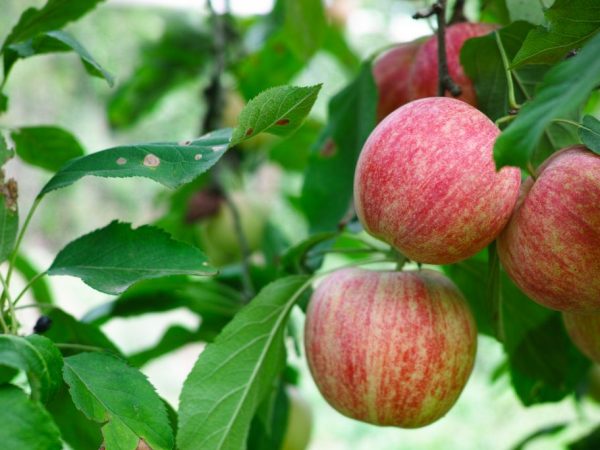
Fuji japanese apples
Advantages and disadvantages
The Fuji apple tree has won the hearts of consumers in many countries for a reason, it has a number of advantages. The main ones are:
- beautiful presentation and excellent taste of the fruit;
- long-term storage of the crop;
- crunchy sugary pulp;
- quick adaptation to new regions and climate.
Due to the high sugar content, the fruits are valued in factories that produce juices, purees, and canned fruit. Saplings are sometimes transported hundreds of kilometers away to grow delicious fruits in their garden.
The variety is not devoid of a number of disadvantages:
- the need for crown formation;
- the harvest is periodic;
- low resistance to disease;
- poor quality of the first harvests.
These few disadvantages do not interfere with growing apple trees on an industrial scale. After all, it is not difficult to sell products. Customers quickly sort it out in supermarkets.
Variety characteristic
To better understand all the features of apples, carefully study their description.
It is worth saying that the Fuji apple variety was considered exotic for a long time in Russia, but now it is gaining more and more popularity among gardeners. Received a variety by crossing the Hungarian Roll Janet and American Red Delicious. The variety retains some of the characteristics of its parents.
Description of the tree and fruit
Fuji's tree is tall and sturdy. The shape of the crown depends on the method of formation, it is round, columnar, spherical.
Height without pruning - 9 m, with pruning - 4-6 m. Bark color - light brown, with a slight gray tint.
- Young shoots are bright green, few lentils.
- The branches grow chaotically, in different directions.
- The surface of the trunk is slightly wrinkled.
- Leaf shape - lanceolate-oval or oval, pointed tips.
- The growing plates are pubescent, the formed leaves are smooth, glossy.
- The petioles are attached to the twigs at an acute angle.
Fuji apples stand out from others. Fruit weight - 200-250 g, diameter is more than 7.5 cm. The shape is correct, round. The rind is dry and matte.
They have a very beautiful color: the main color is bright red, with a pink or crimson tint, yellow dots are present on the entire surface, as well as yellow and greenish blurred stripes - this is their characteristic feature.
The pulp is white or creamy, with a delicate texture. The core is medium in size, the seeds are thin, light.
Some apples grow into real giants. But within the same tree, the sizes are approximately the same.
Composition and calorie content of apples
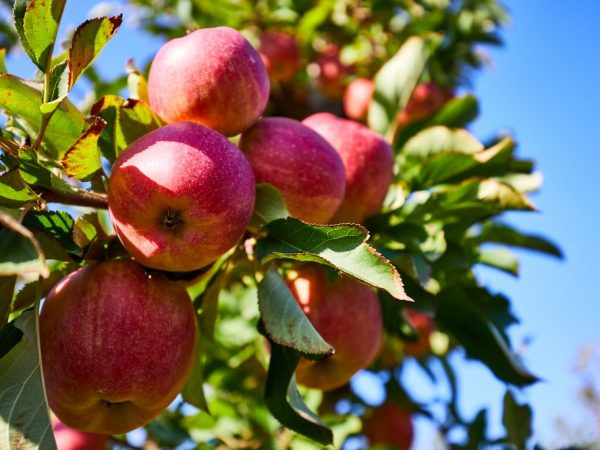
Fruits contain a lot of vitamin C
Fuji has a high sugar content - up to 9-11%, which affects the number of calories. 100 g of product contains 71 kcal.
The composition of the BZHU (per 100 g):
- proteins - 0.36 g;
- fats - 0.24 g;
- carbohydrates - 19.06 g.
Fruits contain a lot of potassium, up to 148 mg / 100 g. There is little sodium in them, only 1 mg. They also contain a lot of ascorbic acid, B vitamins, carotene.
The composition includes fiber, quercetin and other organic compounds.
Taste
Taste is one of the main advantages of the Fuji variety.
Apples are sweet and sour, with a bright, pronounced aroma. The redder the fruit, the more sugar it contains. The pulp is plump, juicy and crunchy, it remains so until spring and even until the beginning of summer when properly stored.
Tasters highly appreciate the fruit - 4.9-5 points out of five possible.
Useful properties and contraindications
The rich composition of apples provides their beneficial properties. Fiber is good for regulating bowel function, and dietary fiber lowers cholesterol levels. Quercetin is a cardioprotective agent that also lowers blood glucose levels.
Fruits are allowed to be eaten with diabetes mellitus. Not too high in calories allows you to use them for weight loss.
- Potassium normalizes heart function, enhances contractions, prevents heart attacks.
- Vitamin C is stored until the end of winter, when this compound is not enough in the diet. It strengthens the immune system, strengthens blood vessels, and improves skin condition.
- Vitamin A and carotene are great benefits for hair, eyesight.
- Group B - protectors of the nervous system, ensures normal hematopoiesis.
There are almost no contraindications to eating apples. They are not recommended for people with allergies to red fruits and individual intolerance.
It should be used with caution in case of intestinal diseases (Crohn's disease, ulcerative colitis, irritable bowel syndrome), the fruits can harm the body. In such situations, it is worth eating the apples not raw, but baked.
Yield
From one tree, 200-300 kg of fruit can be harvested per season. But high yields are not observed every year. After abundant fruiting, the apple tree takes a break.
To consistently harvest, it is recommended to thin out the ovaries.
Pollinators
Like many other honeycomb apple trees, Fuji does not self-pollinate well. This is due to the genetic characteristics of the species. To maintain phenotypic diversity, evolution has provided for the incompatibility of pollen and pistils from the same tree.
The apple tree will bear fruit well if pollinators are planted nearby. Suitable for this variety:
- Ruby;
- Ligol;
- Gala;
- Red Delicious;
- Idared;
- Pinova;
- Grenie Smith;
- Everest.
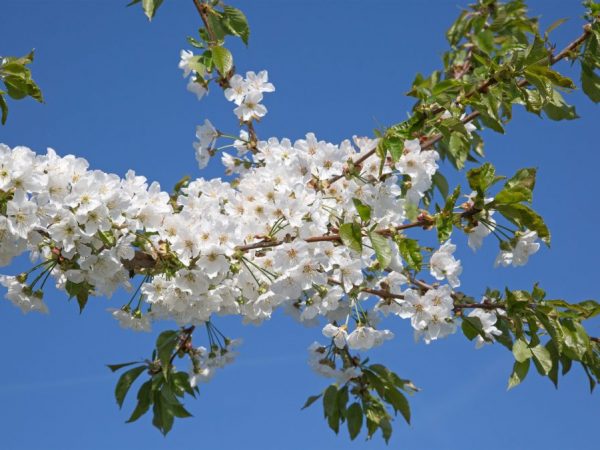
Pollinators increase yields
It is recommended to plant 1 pollinator for 10-12 trees. The distance between them should be 50-100 m. Sometimes they practice planting 1 pollinator row on 2-3 rows of the main variety.
Winter hardiness
Fuji variety has good winter hardiness. The tree is able to withstand frosts down to - 25⁰С. It tolerates winter temperature drops, alternating thaws and cold snaps.
But long and lingering frosts can ruin the culture.
Winter hardiness of different clones may differ.
Disease and pest resistance
The variety is not very resistant to fungal and bacterial infections. Therefore, it requires constant preventive treatments.
Most often it is susceptible to:
- powdery mildew;
- bacterial burn;
- scab (medium resistance).
Products containing copper (for example, copper sulfate) help against fungi (scab and powdery mildew). The use of industrial fungicides is also recommended.
A bacterial burn is sensitive to antibiotics (gentamicin, rifampicin, streptomycin).But in many cases the tree cannot be saved.
Among the pests, the most dangerous are:
- apple flower beetle;
- green aphid;
- moth.
To get rid of them, the tree is treated with insecticides. Helps mulch and whitewash of trunks slaked with lime. In the fall, be sure to remove all the leaves.
Eggs and larvae of pests overwinter well under such a litter; it becomes a natural breeding ground for fungi and bacteria.
Growing regions
Although the apple tree is resistant to cold weather, it is not recommended to grow it in the northern regions. Even for the Moscow region, it is suitable only conditionally.
The fact is that for sugar content and red blush, she needs a lot of sun. The further north you go, the more sour the fruits will be.
In the USA, this variety is cultivated in the states of New York, California, Washington. There are many gardens in central China. It is perfect for Ukraine, south and center of Belarus.
In Russia, he fell in love with gardeners in Stavropol, Kuban, Krasnodar Territory, Caucasus, Bryansk, Rostov regions. Some modern clones have a shorter growing season; they have taken root in more northern regions, in the Central zone.
Tree lifespan
Standard tall trees live approximately 50 years. At the same time, they bear fruit for 30-40 years. Dwarf rootstocks are not so long-livers, after 25-30 years they stop yielding and dry up.
The shortest life span in the columnar type is up to 15-18 years. You can lengthen the growing season by rejuvenating the crown, dressing.
Landing
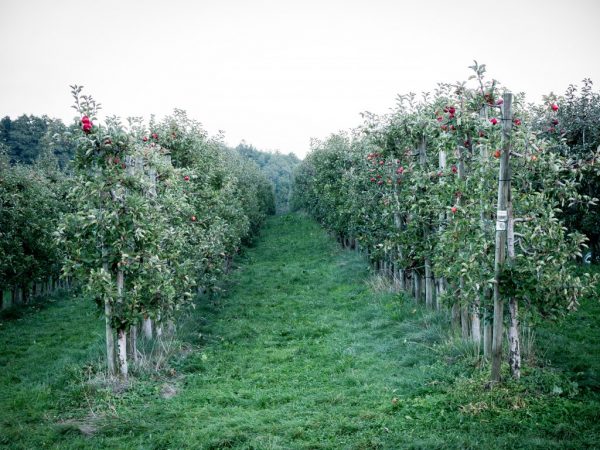
The variety is suitable for cultivation in the southern regions.
In order for young seedlings to take root, grow quickly and give a crop, they must be properly planted. There are no difficulties in growing Fuji apple trees, even a beginner can cope with all the stages.
Timing
You can plant trees in autumn or spring.
If you plant an apple tree in October, then by the spring its roots will strengthen and will nourish the young seedling. But in winter, the crown can freeze, and the trunk is often eaten by hares or other rodents. To prevent this from happening, the branches are carefully covered.
Spring planting begins in late March or early April, when the ground warms up well.
During the summer heat, the root system will have time to take root and begin to supply moisture to the branches. Such terms are more acceptable for regions with cool and temperate climates, for example, for the Moscow region or the Bryansk region.
Seat selection
The variety loves the sun, only in such conditions apples ripen well and gain a lot of sugar.
It is better to plant Fuji on the south side. The place should not be in the shade. The ideal option is a small hill, sheltered from the wind.
The soil on the site should be fertile, neutral or slightly acidic. The variety grows well on black soil, with minor admixtures of sand or clay.
It is advisable to choose a place with deep groundwater. If their level is higher than 1 m from the surface, the roots will rot and the seedling will die. To prevent this from happening, it is necessary to arrange good drainage and plant an apple tree in a shallow hole, fill in an artificial mound.
Landing technology
For planting, it is better not to take large seedlings, which are often brought to markets. Small trees, 1-2 years old, take root faster.
When buying, carefully inspect the roots, remove any broken and rotten ones. Prepare a 1% solution of copper sulfate and lower the tree in it for 4-5 minutes. After that, it will be completely ready for planting.
The hole should be dug 2-3 weeks earlier. If you plan to plant in spring, the place should be prepared in the fall. The depth and width should be 60-80 cm. If the soil is clayey, a little river sand is placed on the bottom.
Good drainage from expanded clay or pebbles will not interfere. To increase the fertility of the soil, adding half a bucket of humus or well-rotted manure.
Before planting, a small mound is built at the bottom, the roots are straightened and the tree is planted on top. Sprinkle with soil so that the root collar protrudes slightly above its surface. Pour 2-3 buckets of settled water.
The distance between seedlings depends on the type of rootstock.
- If it is standard, you need to provide 4 m.
- For dwarfs, 3-3.5 m is enough.
- For columnar - 2.5 m.
The distance between the rows is 6 m, 4.5-5 m and 4 m, respectively.
Care rules
To get a good harvest, apple trees need to be properly cared for.
Watering
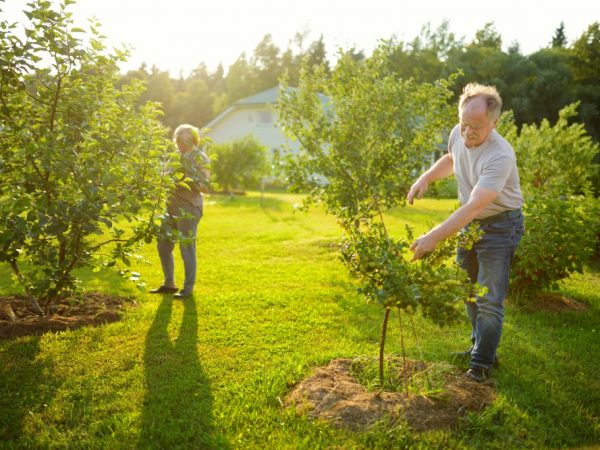
The tree needs to be well looked after
Trees are watered in dry weather, 3 to 10 times per summer. The amount of water depends on the age.
Under a seedling, it is enough to add 2-3 buckets of water, under a young apple tree - 5-7 buckets, and under an adult tree - up to 10 buckets.
After the procedure, be sure to loosen the soil. In the early years, a circle with a diameter of 80-100 cm from weeds is weeded.
Top dressing
Fertilizers are applied in spring and after harvest. The first feeding should contain a lot of nitrogen, which stimulates growth and green mass gain.
A nitrophoska or mullein diluted with water 1:10 will do. After the end of the growing season, potassium-phosphorus mixtures (superphosphate, potassium chloride) are introduced.
In late autumn, they make mulch from humus around the tree, it will protect the horses from the cold, and in the spring it will feed them well.
Crown formation
The variety has a tendency to thickening and improper growth of branches, therefore, special attention should be paid to the procedure. Pruning begins in the second year after planting.
The tiers are formed according to the following plan:
- stem height - 50-80 cm;
- between the first and second tiers - 60-80 cm;
- between the second and third - 20-30 cm.
In the first tier, 5 branches are left, in the second - 3-4, in the third - 2-3 shoots.
In the second year, the top is pruned to stimulate the growth of the lateral branches. All shoots are shortened by a third of their length. Formative pruning is completed in the fifth year. Then they do sanitary and anti-aging manipulations.
The tree is pruned in late February or early March, until the juices begin to circulate. Remove any shoots that are too close to the trunk, broken and showing signs of disease. Do not leave branches that are thicker than the central trunk.
Preparing for winter
Young trees in regions with cold winters are sheltered for the winter. It is recommended to use a special agricultural film.
Be sure to tie the trunk to protect it from rodents. Near the roots arrange a mulch of straw, high-moor peat with the addition of humus.
Features of ripening and fruiting
After planting, the first fruits are harvested no earlier than 4 years later. By that time, the tree is growing. The crown is almost formed, there are 3 tiers of branches on the trunk.
If the apple tree blooms earlier, you need to pluck all the ovaries. Early fruiting can deplete the plant and it will die.
Fuji reaches its maximum yield at 15 years. Flowering begins late, in late April or mid-May.
Flowers form well if the average daytime air temperature is 15-22⁰С. Therefore, in the northern regions, they appear later. The period lasts 6-12 days (in hot weather it is reduced, and in cold and wet weather it is delayed).
The apples are pouring slowly. It is recommended at this time to spray the plant with nitrogenous and phosphorus foliar dressings. They not only contribute to a good harvest, but also prevent fungal diseases, repel and destroy pests.
If there are too many ovaries, the fruits will be small, and the next year the apple tree may not germinate at all. Therefore, it is imperative to thin them out. This is especially important in the early years.
Harvesting and storage
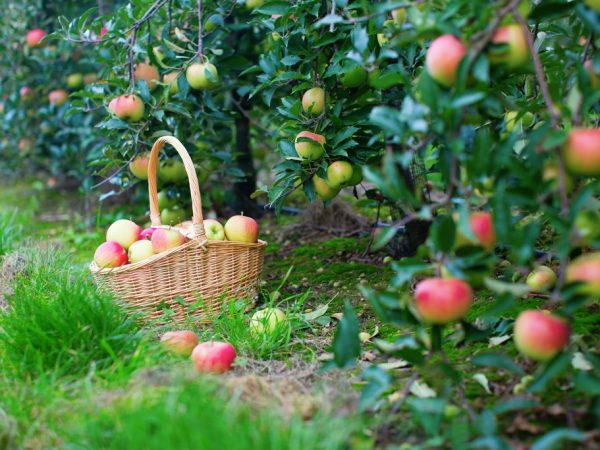
Ripe fruits taste sweet
Fruits ripen from late September to late October, depending on the climatic zone. They are not prone to falling off.
The longer the fruits hang on the branches, the redder and sweeter they become. They need 3200 hours of sunshine to fully mature.
There is no need to rush to harvest.
- In the south, it begins in early October.
- In the northern regions they even reach the last weeks of the second autumn month.
It is important to ensure that early frosts do not destroy the fruits.
Apples are harvested by hand.They are put in wooden boxes, restoring each layer with straw or waxed paper. A good option is to pack each fruit separately. Then they will not be "infected" with rot from each other. Damaged and diseased fruits are immediately put aside.
Fuji is a winter variety. He fully demonstrates the taste of soybeans one month after harvest. Under normal conditions, it is stored for 3-4 months.
If products are placed in a cold basement or refrigerator, then they are sold until the end of spring. Optimum storage conditions are temperature 3⁰С and humidity 90%.
Clones
Fuji is a very popular variety. Many gardeners and breeders became interested in him and decided to breed clones. Today there are about a dozen of them.
The most famous:
- Aztec;
- Kiku;
- Yataka;
- Red (Nagafu);
- Toshiro;
- Cancer-Cancer;
- Beni Shogun;
- Fubrax.
Aztec
Fuji apple clone, Aztec, bred in New Zealand in 1996. Differs in regular fruiting.
Apples are juicy, rich red, with a sweet taste and juicy pulp, weighing up to 200 g. Fruits are stored for up to 7 months.
They begin to ripen in the second half of September, pollinated by the Gremi Smith variety, moderately resistant scab.
Kiku
A medium-sized, high-yielding winter Kiku clone recently bred in Japan. It ripens in the second half of October and is highly winter-hardy. Well suited for growing in temperate zones.
The fruits are large, weighing 250-300 g, the surface is pink, the taste is sweet with sourness. The tasting characteristics are even superior to the original.
Yataka
Yataka apples have a carmine-red peel with pronounced stripes, weigh 250-350 g. They taste sweet and sour, have a long shelf life and are suitable for processing. Ripen in the first days of October, a little earlier than the main variety.
Productivity is high, ovaries sometimes require thinning. Immunity is weak, prone to scab, powdery mildew, fire blight.
Red (Nagafu)
Ripening begins in the last decade of September. The fruits are red with a raspberry tinge. It tastes sweet, weighing 250-300 g.
Differs in good keeping quality and transportability, high winter hardiness. Trees of medium height, regular fruiting.
Toshiro
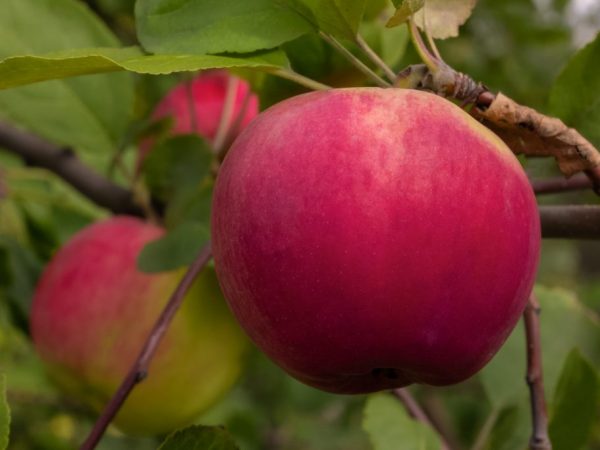
The Toshiro variety is grown commercially
Distributed in China, Japan and Korea, it is grown on an industrial scale.
Toshiro is also suitable for the climate of the Moscow region. Ripens at the end of September.
Fruit weight - 200-250 g, the surface is pink-red. Immediately after collection, they have a pronounced acidity, which disappears until the end of September.
Cancer-Cancer
A medium-sized tree with a lush crown. Fruits are round or slightly elongated, have a blurry pink color with pronounced yellow subcutaneous dots.
The taste is dessert, the pulp is tender and juicy. The clone is scab resistant, sensitive to powdery mildew.
Beni Shogun
Secondary clone, descended from Yataka. Beni Shogun is especially popular in the USA.
Differs in good winter hardiness, resistance to powdery mildew and rust, sensitive to scab. The apples are large, weighing up to 350 g.
The peel is bright red, the middle is white, the taste is pronounced sourness, the aroma is bright and pleasant.
Fubrax
Fubrax apples are large, green in color with a red-violet or pink blush covering the surface of the fruit in stripes. Ripening period - end of September. Taste is harmonious, dessert, aroma is expressed.
There are disadvantages - irregular fruiting, sensitivity to scab and fire blight.
Rootstock options
Fuji can be grafted onto different rootstocks grown from seeds.
Since the original tree is tall and requires a lot of space, its species are becoming more and more popular among gardeners - dwarf and columnar.
Dwarf
The height of the dwarf rootstock is not more than 2.5 m. In the place where the tall species grows, 6 small ones can be planted. He begins to bear fruit as early as 3 years old. At 10 years old, it reaches its maximum performance. Lives up to 20-25 years.
The compact size helps save space in the garden.It is easier to harvest from low apple trees, it is easier to care for them. Since the roots of the dwarf rootstock are short, it is regularly watered. Mulch must be made on the trunk circle.
Columnar
The columnar rootstock has no lateral branches, the shoots grow upward almost parallel to the trunk.
Such an apple tree takes up very little space, the distance when planting between individual specimens can be 50-80 cm.
In place of one large tree, 10-12 columnar trees are planted. Often they are tied to a net so that thin branches and trunks do not break under the weight of the fruit.
The first crop appears already in the second year. At 7-8 years old, fruiting is the most abundant. By the age of fifteen, the apple tree is depleted.
Suitable for industrial cultivation. Allows you to quickly change varieties if the manufacturer sees changes in market demand.
Reviews of gardeners about the variety
Underneath the description of Fuji by gardeners, you can read many rave reviews. For example, many write that they have never eaten such delicious apples. Some argue that they replaced all other fruit crops from their garden with this variety. There are even those who fell in love with apples after trying this particular variety.
According to gardeners, apples grown in their own garden are much superior in taste to purchased ones. Indeed, commercial enterprises do not always wait for the final ripeness. And Fuji gets to the condition on the branches even when it seems fully ripe.
Many people prefer clones - Kiku, Beni Shogun, Aztec. They argue that they bear fruit better, lack the frequency characteristic of the parental species, and even better adapted to the conditions of the central zone of Russia.
Fuji is a good variety that can be grown by both professionals and amateurs. It has a dessert taste with high tasting qualities. The harvest is stored for a long time, suitable for juices, preserves, marmalades, jams.
Buyers in many countries have appreciated the fruits of Japanese breeding.

